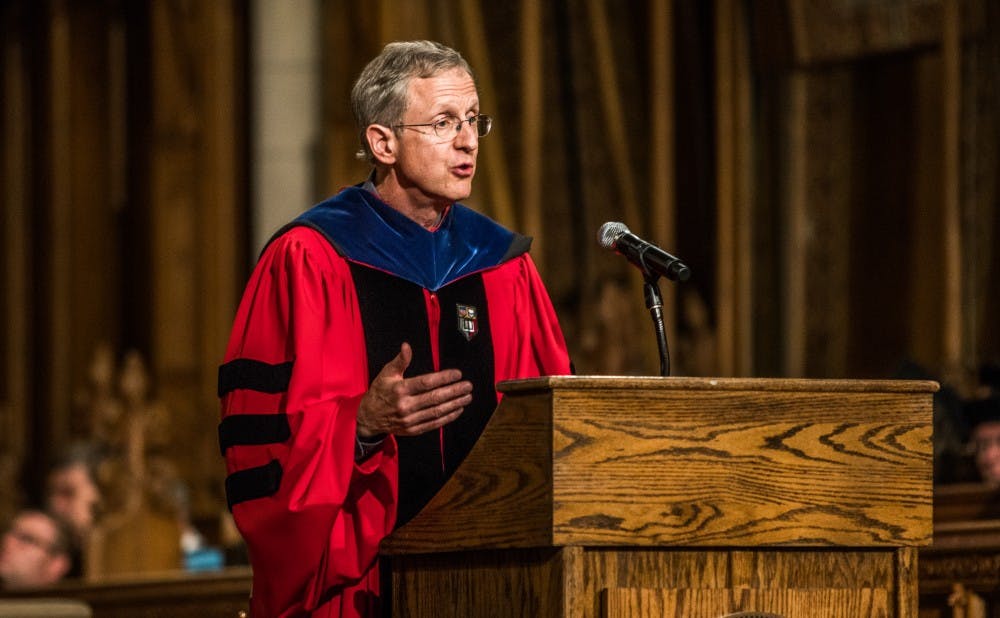If the sentimental ideal of the American Dream hinges on the possibility of upward social mobility, then Duke students may be in for a rude awakening.
According to a study recently published in The New York Times, only 1.6 percent of students came from families in the bottom 20 percent of the income distribution and moved up to the top 20 percent later in life. The study also highlighted a significant lack of socioeconomic diversity—in 38 schools, students from the top one percent outnumbered students from the bottom 60 percent. Duke ranked 26th out of the 38 in greatest disparity between number of students from the top one percent and bottom 60.
“I wasn’t surprised because this isn’t really a Duke problem—it’s an issue in private American higher education in general, and we’ve known this for a while,” said Steve Nowicki, dean and vice provost for undergraduate education. “To put it in the stark terms of comparing the one percent to the 60 percent sort of brings it into focus, and that is a jarring realization."
The study analyzed millions of anonymous tax records to gather the socioeconomic data for students in the Class of 2013 and compare it to the current status of students from the classes of 2002 to 2004 in order to see how the students fare later in life.
The median family income for Duke students from the Class of 2013 was $186,700. Nearly 70 percent of students were in the top 20 percent of the income range, while only 3.9 percent were from the bottom 20 percent.
Duke was grouped with the eight Ivy League institutions, the University of Chicago, Stanford University and the Massachusetts Institute of Technology in a top-tier comparison group. Duke had the third-highest number of families who made above $630,000 and struck the middle ground in regards to students who hail from the top 20 percent, having the sixth highest number of families in this top quintile.
"To get to the very top is hard. The question is, are you going up? Are you going into a solid, upper-middle class job? I mean, I’ll never be in the one percent,” Nowicki joked.
Although the study showed that Duke alumni had the fourth highest income at a median of $87,500, the study also found that there is a large discrepancy between women's and men’s median income.
For Duke’s male graduates, the median income at age 34 is $107,800—almost 1.5 times higher than that of the median income for females at $72,300. This difference was the greatest among peer institutions. The University of Chicago was on the opposite end of the spectrum, with only a $14,800 difference.
One population the study did not measure was international students, which make up 14 percent of Duke’s undergraduate population. At Duke, international students who need financial assistance are subject to a different admissions process than those who do not need the University’s aid.
“The international students who ask for aid were put in a highly competitive pool, and only like one percent of them got in,” Nowicki said. “We only had so much aid to give them, so it was very much need-aware.”
Although the University is limited in the financial aid it can offer to international students, Nowicki highlighted a number of programs that Duke utilizes to combat the socioeconomic gap domestically.
The University recently joined the nonprofit Questbridge and introduced the Washington Duke Scholars program, which Nowicki said he expects to facilitate a “big uptake” in the number of first-generation low income students.
“The [study’s] findings don't mean we don't have a significant population of students receiving financial aid, many of whom are low income students,” wrote Alison Rabil, assistant vice provost and director of financial aid, in an email. “About half our population receives some kind of need-based assistance at Duke, and if you include athletic and merit aid more than half our population receives funding from the University to attend.”
Nowicki noted that the systemic nature of socioeconomic disparities—which he noted stems from issues in the K-12 education system—limits the ability of the University to address it.
“It isn’t as though Duke is saying, ‘Hey, let’s get these wealthy kids in here and to heck with the rest of them.’ It’s a consequence of the overall effect of socioeconomic disparity on higher education—which is an issue,” said Nowicki. “I’m not saying that we are off the hook. We have to deal with that.”
Claire Ballentine contributed reporting.
Get The Chronicle straight to your inbox
Signup for our weekly newsletter. Cancel at any time.
Bre is a senior political science major from South Carolina, and she is the current video editor, special projects editor and recruitment chair for The Chronicle. She is also an associate photography editor and an investigations editor. Previously, she was the editor-in-chief and local and national news department head.
Twitter: @brebradham
Email: breanna.bradham@duke.edu

